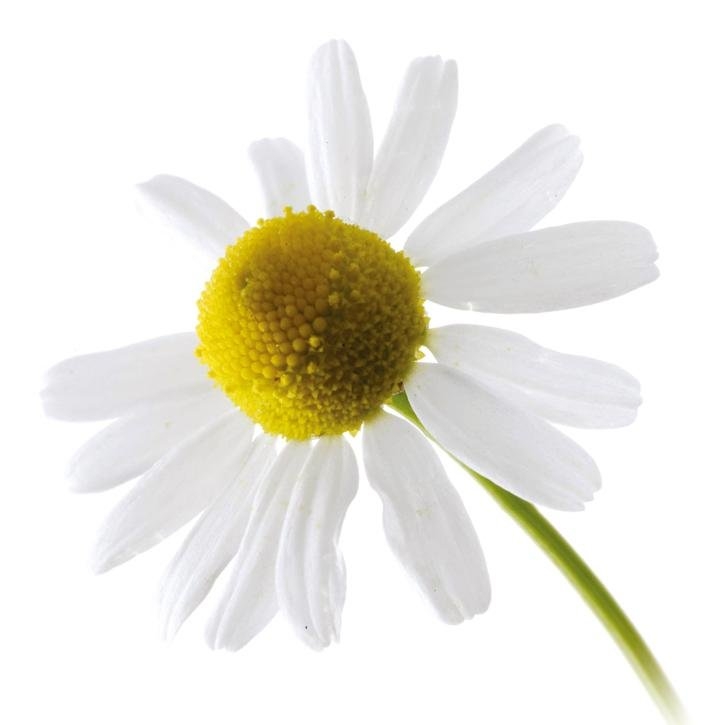Anthemis nobilis L o Chamaemelum nobile (L) All.
Description
Herbaceous, vivacious, villose plant, 10-30 cm high; branched rhizome that makes the plant grow just above the ground. Leaves are alternate, whitish-green, 1.5-5 cm with glandular dots, pinnatisect, divided into narrow lobes, in linear segments and finely sharp apexes and a rolled-up margin. Terminal and solitary capitules are of up to 3 cm diameter. The receptacle is firm, conic and full; its base is surrounded by an involucre formed by 2 to 3 lines of tight and imbricated bracts, scarious at the edges (dry and translucent). Flowers around the capitule have a white ligule corolla, pale, lanceolate and flexous, with a dark brown inferior ovary, a filiform style and bifidus stigma. Inside flowers are yellow, tubular with small transparent florets between them. They have a corolla with 5 teeth, androecium with 5 epipetalous and gynocium pistils similar to the ligule flowers; they are hemafrodites. The fruit is an achenium, no longer than a millimeter in length and with no pappus. It has an intense aromatic, penetrating and characteristic scent. It belongs to the Asteraceae (Compositeae) family.
It is indigenous of southern and western Europe (England, Belgium, France, Germany, Italy, Spain) and northern Africa. To produce the drug, it is cultivated, mainly in Belgium, France, England, United States, Argentina and Italy, a kind of Chamomile with mostly only ligule flowers. The drug comes, especially from France, Poland and Czech Republic.
Habitat: In the wild, it can be found in meadows and fields lengthwise the Iberian Peninsula, especially in the western and northern regions; by the northeast and south east, it becomes scarce or even totally disappears. Chamomile blooms during spring-summer and is to be harvested during the blooming, when the flower heads open.
Part used
Flower heads (capitula).
Indications
Internal use
- Digestives alterations: hyposecretive dyspepsia, aerophagia and meteorism, epigastric distention, appetite enhancer (to be taken before each meal), hard digestions (to be taken after each meal), gastrointestinal spasms, emesis of nervous origin, nausea, gastritis.
- Hepatic disorders: hepatobiliary dyskinesia, cholecystitis.
- Intestinal parasites (oxyuriasis).
- Headaches, hepatobiliary origin headaches and neuralgias.
- Menstrual disorders, dysmenorrhea (painful menstrual periods).
- Fever.
- Respiratory infections.
- Inflammations in general and rheumatisms.
- Anxiety, nervousness and insomnia.
External use
- Conjunctivitis and blepharoconjunctivitis, irritated eyelids and tired eyes.
- Skin and mucosa inflammation, including buccopharyngeal cavity and gums (mouthwashes), eczemas, wounds, blisters, burns, etc.
- In frictions for rheumatism, lumbago and sciatica.
- In inhalations to treat throat sores and respiratory tract discomfort.
- In inhalations to treat sinusitis, hay fever and rhinitis.
- For sedative and invigorating bathtubs.
- In sitz baths or ointments in the recto-genital area, vaginal infections.
- Enhances golden hue in blond hair.
Bibliography
- Benigni, R; Capra, C; Cattorini, P. Piante Medicinali. Chimica, Farmacologia e Terapia. Milano: Inverni & Della Beffa, 1962, pp. 706-8.
- Bézanger-Beauquesne, L; Pinkas, M; Torck, M. Les Plantes dans la Therapeutique Moderne. 2ª. Paris: Maloine, 1986, pp. 237-8.
- Bézanger-Beauquesne, L; Pinkas, M; Torck, M; Trotin, F. Plantes Médicinales des Regions Tempérées. Paris: Maloine, 1980.
- Bruneton, J. Elementos de Fitoquímica y Farmacognosia. Zaragoza: Acribia, 1991.
- Fernández, M; Nieto, A. Plantas Medicinales. Pamplona: Ediciones Universidad de Navarra, 1982.
- Paris, RR; Moyse, M. Précis de Matière Médicale. Tome III. Paris: Masson, 1971.
- Peris, JB; Stübing, G; Vanaclocha, B. Fitoterapia Aplicada. Valencia: M.I. Colegio Oficial de Farmacéuticos, 1995.
- Trease, GE; Evans, WCh. Farmacognosia. México D.F. Interamericana--MacGraw-Hill, 1991.
- Van Hellemont, J. Compendium de Phytotherapie. Bruxelles: Association Pharmaceutique Belge, 1986.
- British Herbal Pharmacopoeia. Vol. I. Bournemouth, Dorset: British Herbal Medical Association, 1990.
- Real Farmacopea Española, 1997.
- Pharmacopée Française IX Édition.
- British Herbal Pharmacopoeia, 1983.
- Plantas Medicinales. Thérapeutique-Toxicité. Christiane Vigneau. Masson, Paris 1985.
- Herbal Drugs and Phytopharmaceuticals. Norman Grainger Bisset (Ed). Max Wichtl. CRC Press.1994.
- Plantas Medicinales y Drogas Vegetales para infusión y tisana. Edición española a cargo de: Salvador Cañogueral, Roser Vila, Max Wichtl.1998.
- Matière Médicale. RR Paris- H. Moyse. Masson 1981.
- Fitoterapia: Vademecum de Prescripción. Plantas Medicinales. Colaboran: Asociación española de médicos naturistas. Colegio Oficial de Farmacéuticos de Vizcaya.
- Plantas Medicinales. El Dioscórides Renovado. Pio Font Quer.
- Guía de Campo de las Flores de Europa. Oleg Polunin. Ediciones Omega S.A. Barcelona, 1977.
- Pharmacognosy 9th edition. Varro E. Tyler – Lynn R. Brady – James E. Robbers.
- Farmacognosia. G.E. Trease y W. C.Evans. CECSA.
- 100 Plantes Medicinales. Max Rombi. Romart 1998.
- Pharmacognosy, Phytochemistry, Medicinal Plants. Jean Bruneton. Lavoisier Publishing.
- The Complete German Commission E Monographs. Therapeutic Guide To Herbal Medicines. Mark Blumenthal. American Botanical Council 1998.
- Bulletin officiel Nº 90/22 bis. Ministère des Affaires Sociales et de la Solidarité.
- French Public Health Code.
